Giáo trình Chuẩn truyền tin Hart trong đo lường và điều khiển tự động mạng công nghiệp
To send a HART message, the process transmitter turns ON its AC-coupled current source.
This superimposes a high-frequency carrier current of about 1 mA p-p onto the normal
transmitter output current. The current sense resistor at the controller converts this variation into
a voltage that appears across the two loop conductors. The voltage is sensed by the controller's
receive amplifier and fed to the controller's demodulator (in block labeled "modem"). In practice
the two current sources in the HART process transmitter are usually implemented as a single
current regulator; and the analog and digital (HART) signals are combined ahead of the regulator.
To send a HART message in the other direction (to the process transmitter), the HART
Controller closes its transmit switch. This effectively connects the "Xmit Volt Source" across the
current loop conductors, superimposing a voltage of about 500 mV p-p across the loop
conductors. This is seen at the process transmitter terminals and is sent to its receive amplifier
and demodulator.
Figure 1.2 implies that a Master transmits as voltage source, while a Slave transmits as a
current source. This is historically true. It is also historically true that the lowest impedance in
the network -- the one that dominates the current-to-voltage conversion -- was the current sense
resistor. Now, with some restrictions, either device can have either a low or high impedance.
And the current sense resistor doesn't necessarily dominate.
Regardless of which device is sending the HART message, the voltage across the loop
conductors will look something like that of figure 1.3; with a tiny burst of carrier voltage
superimposed on a relatively large DC voltage. The superimposed carrier voltage will have a
range of values at the receiving device, depending on the size of the current sense resistor, the
amount of capacitive loading, and losses caused by other loop elements. Of course the DC
voltage will also vary; depending on controller supply voltage, loop resistance, where in the loop
the measurement is made, etc.
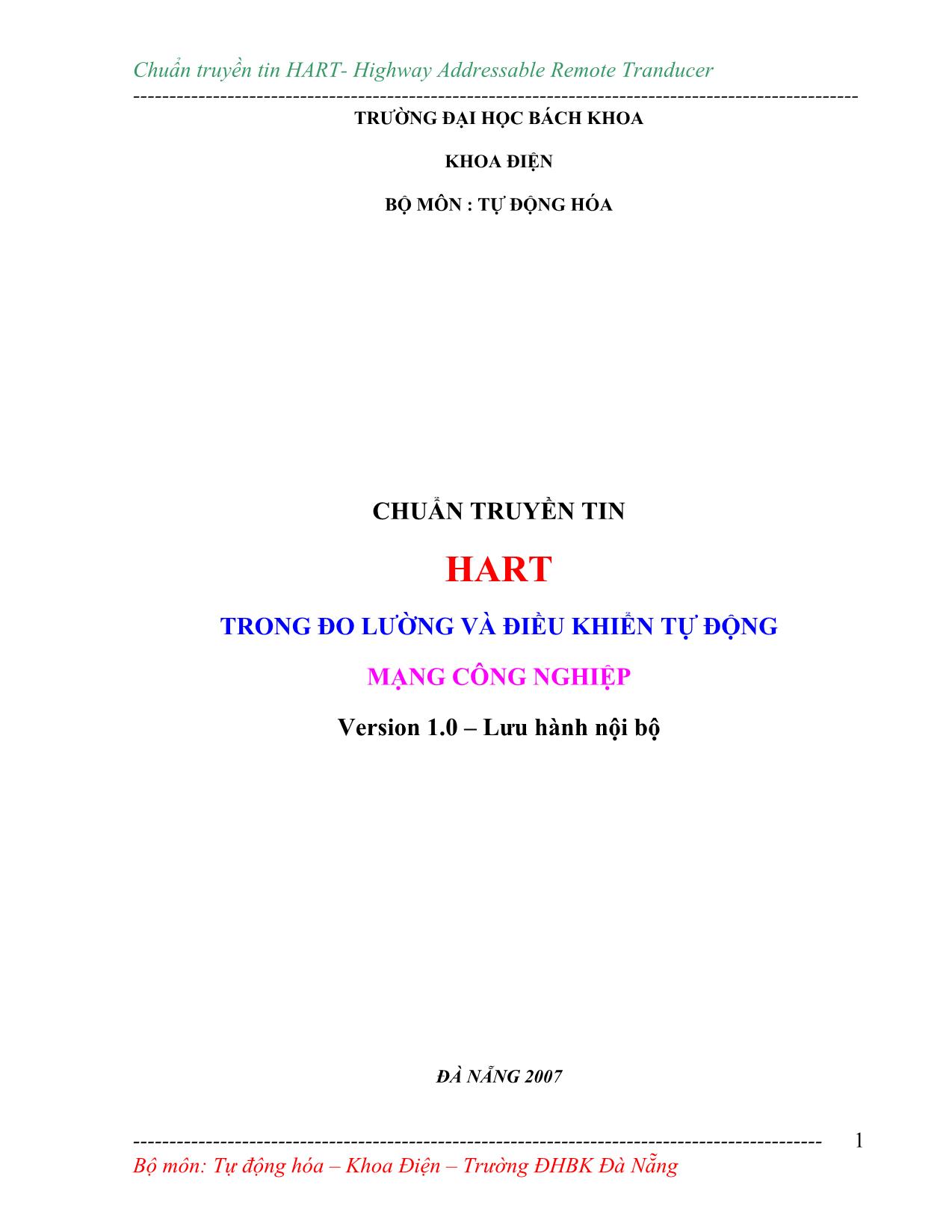
Trang 1
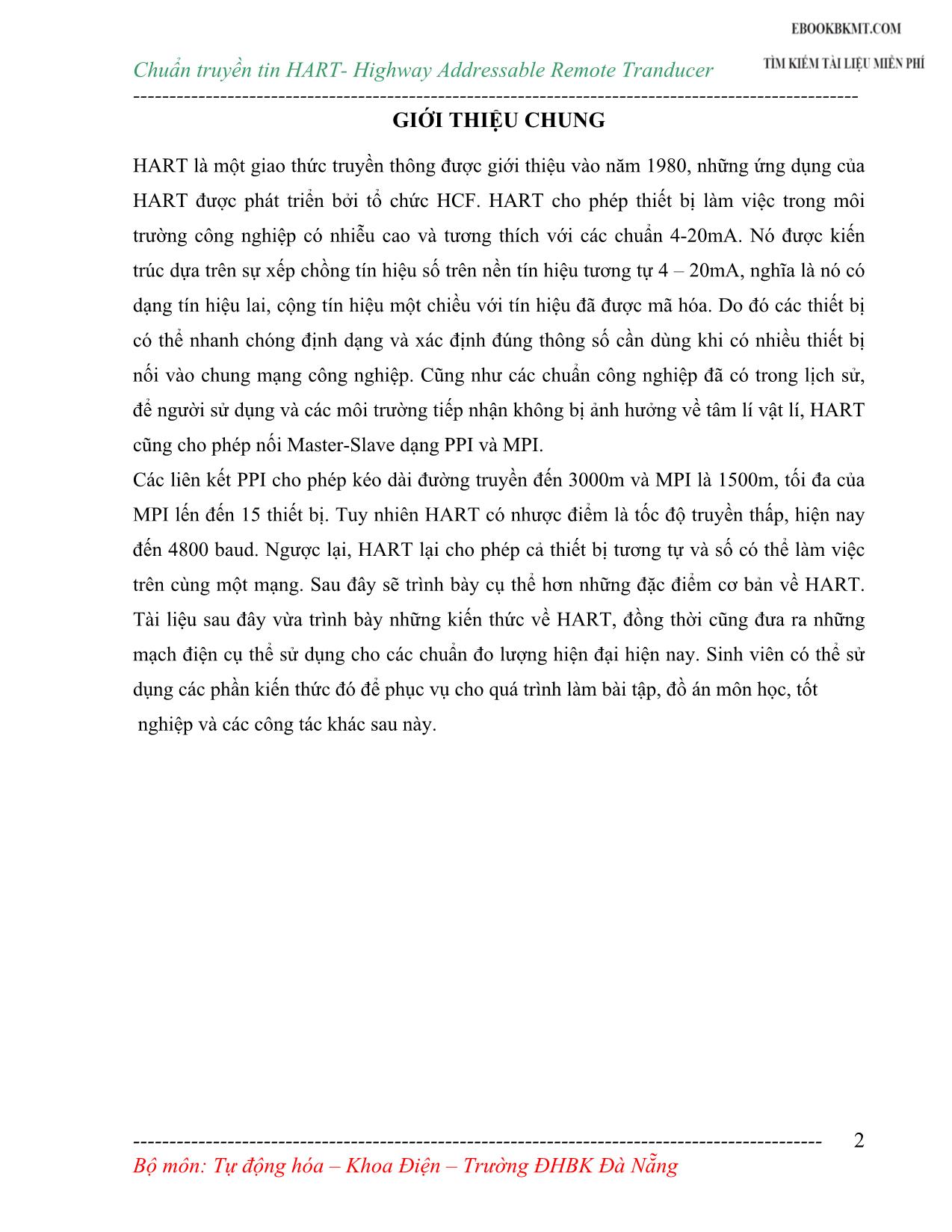
Trang 2
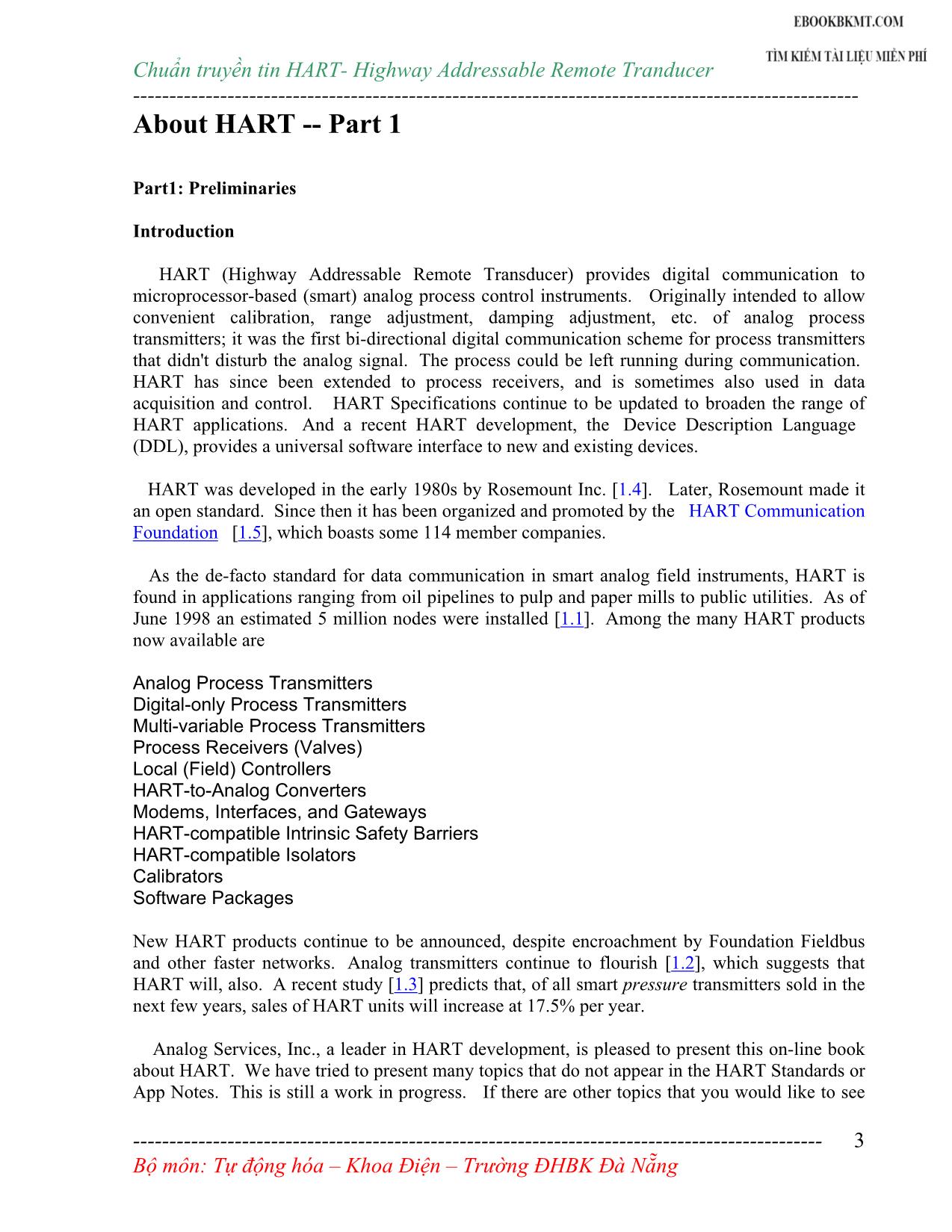
Trang 3
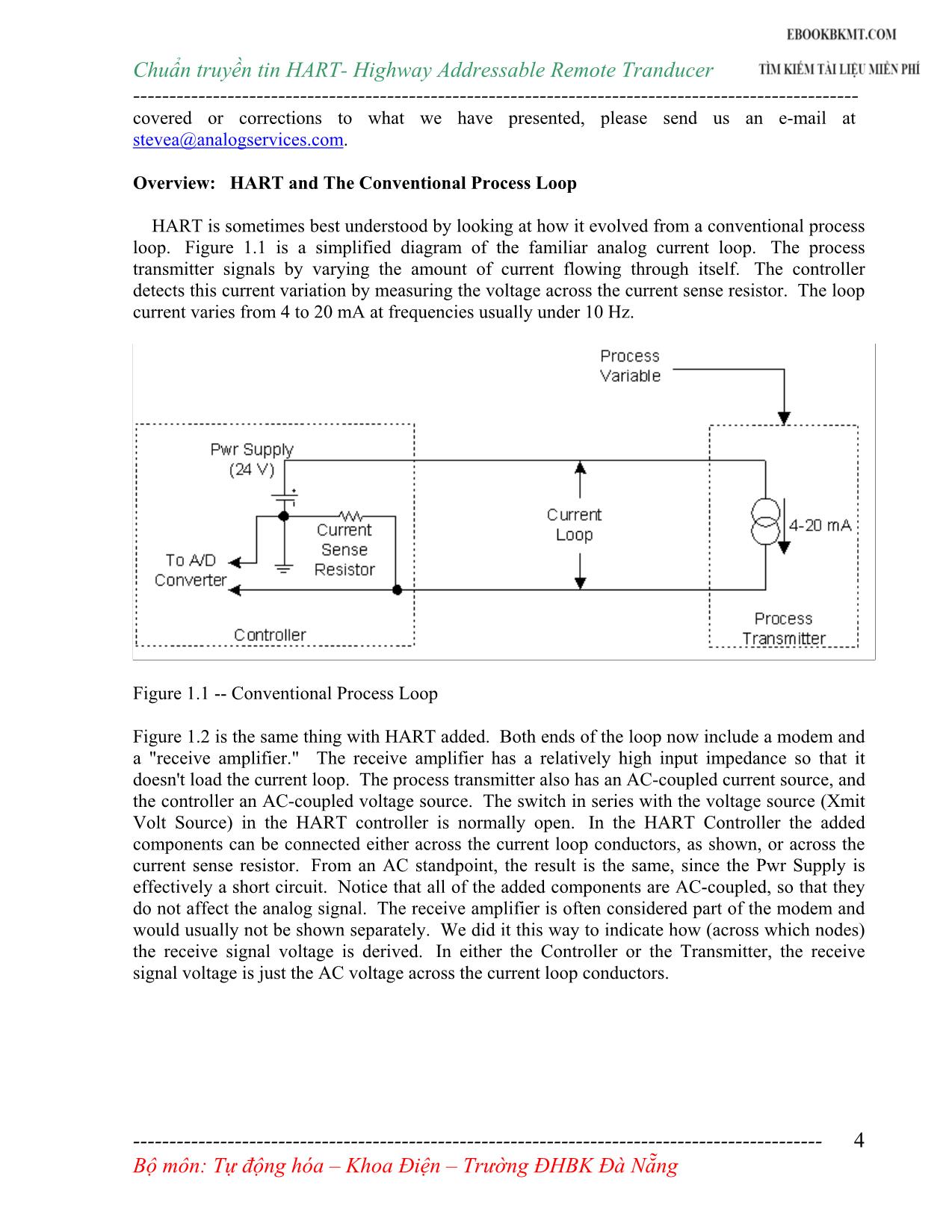
Trang 4
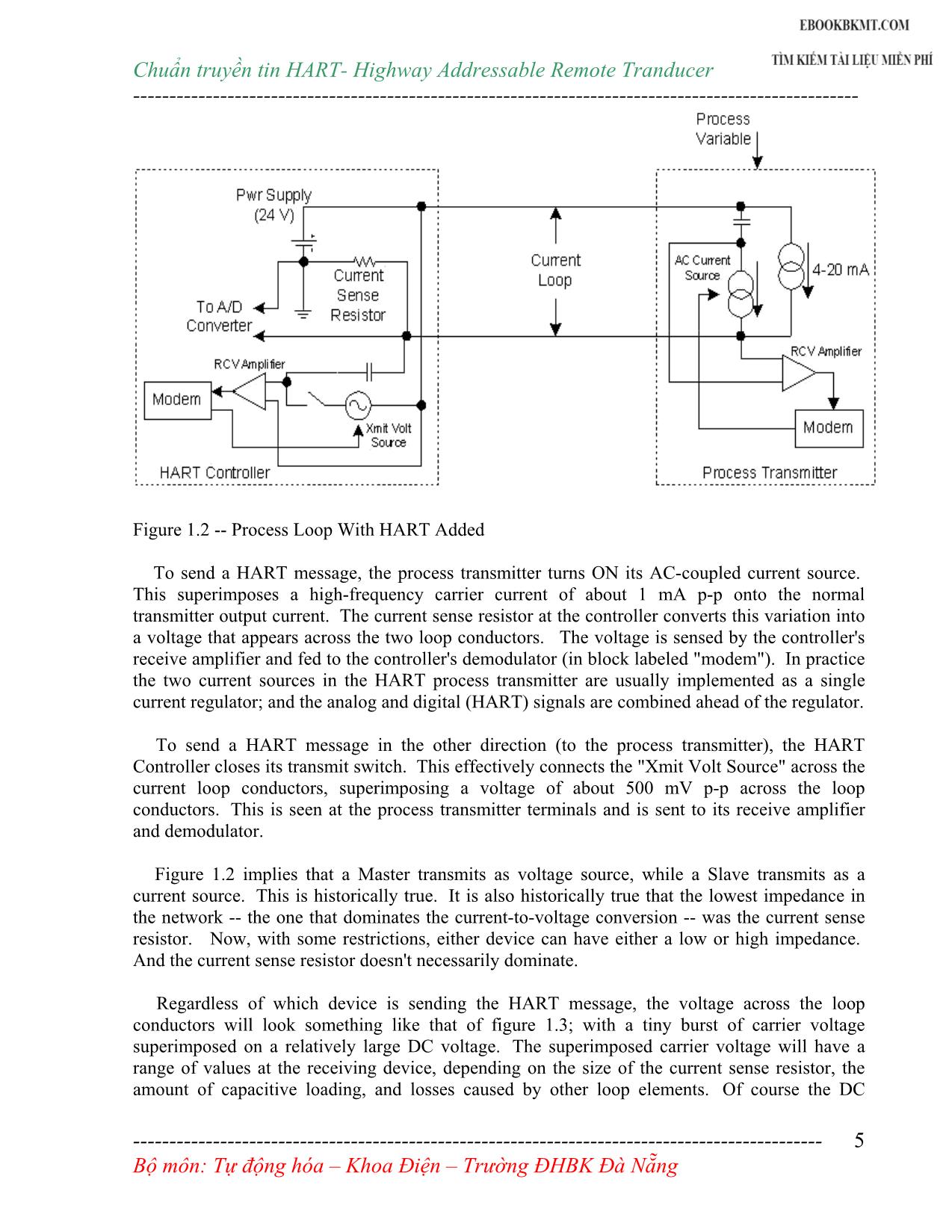
Trang 5
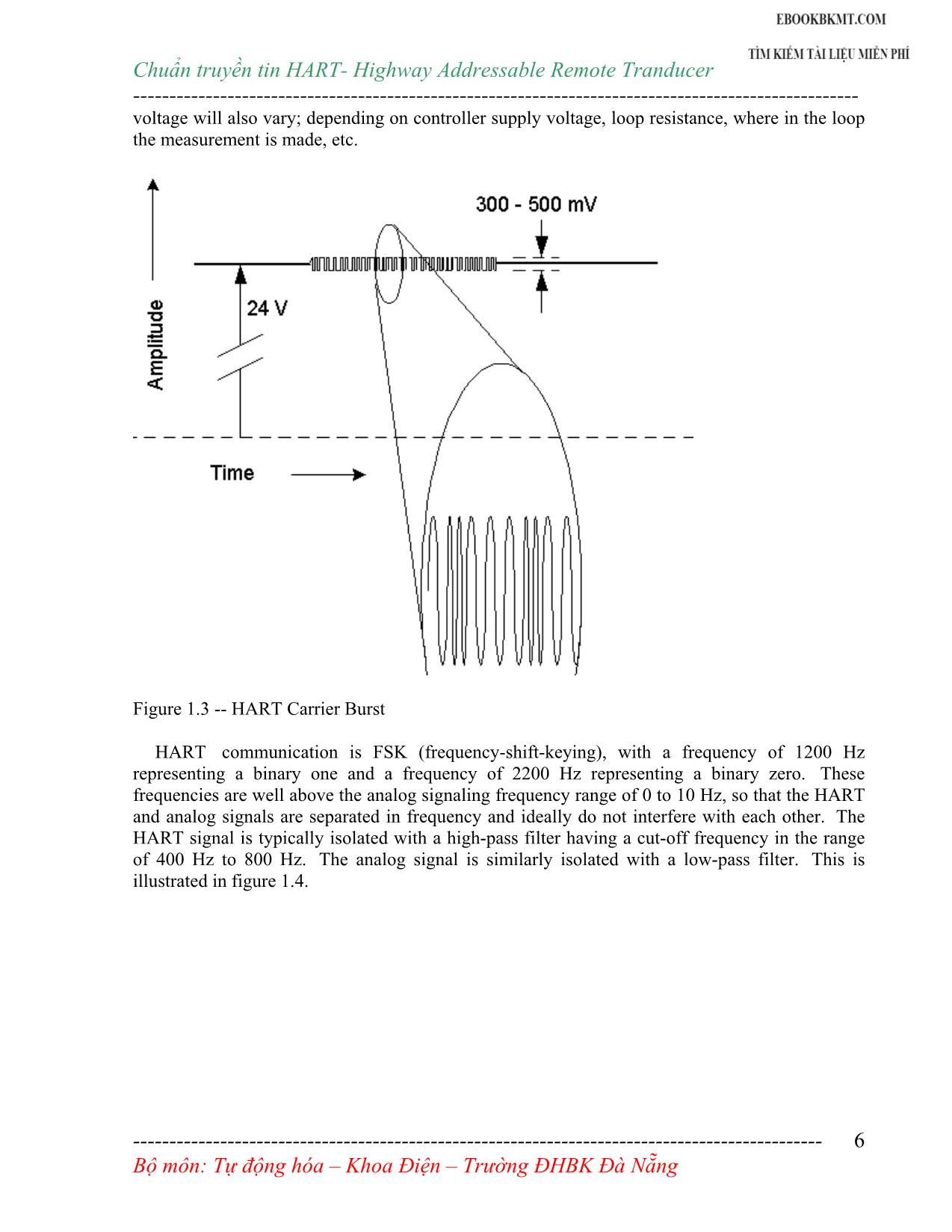
Trang 6
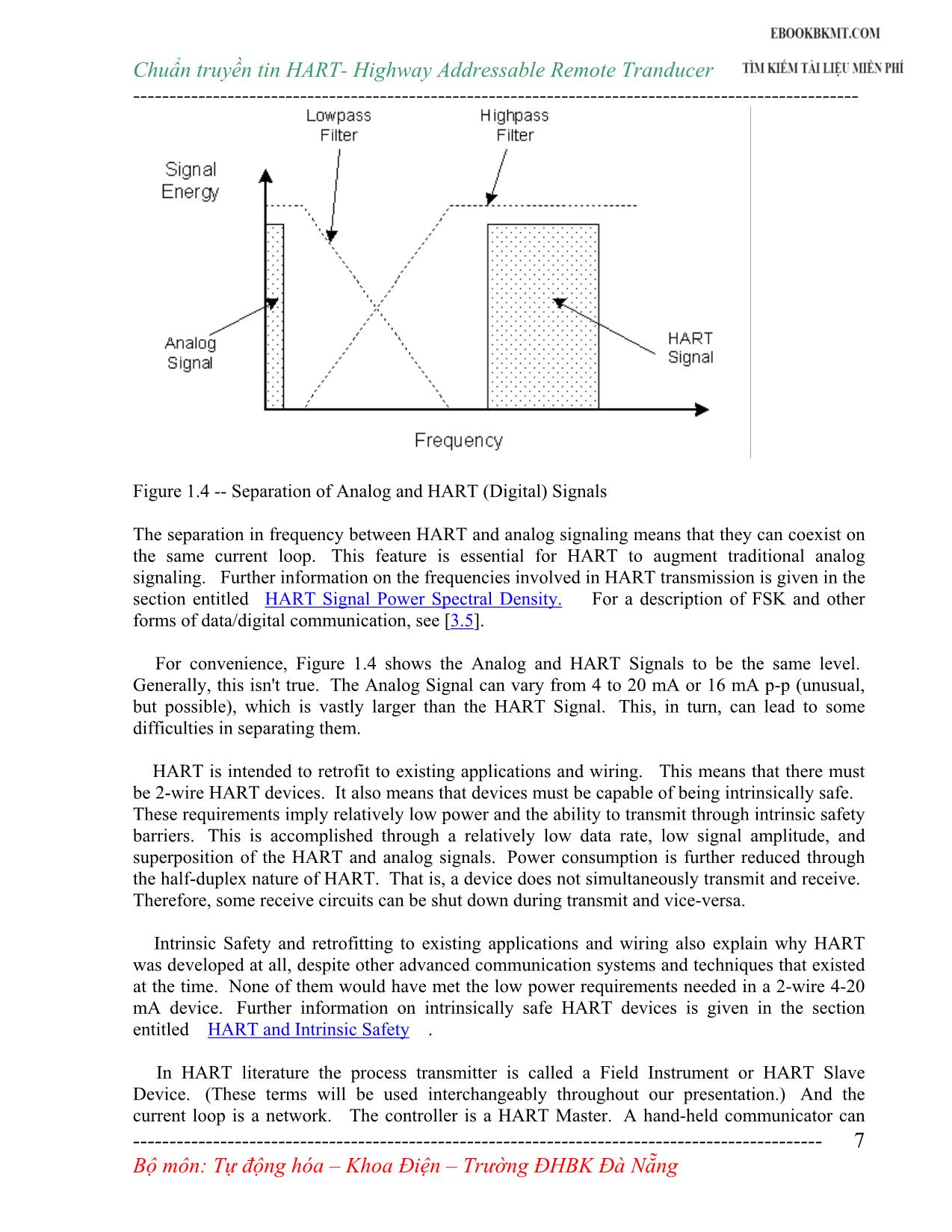
Trang 7
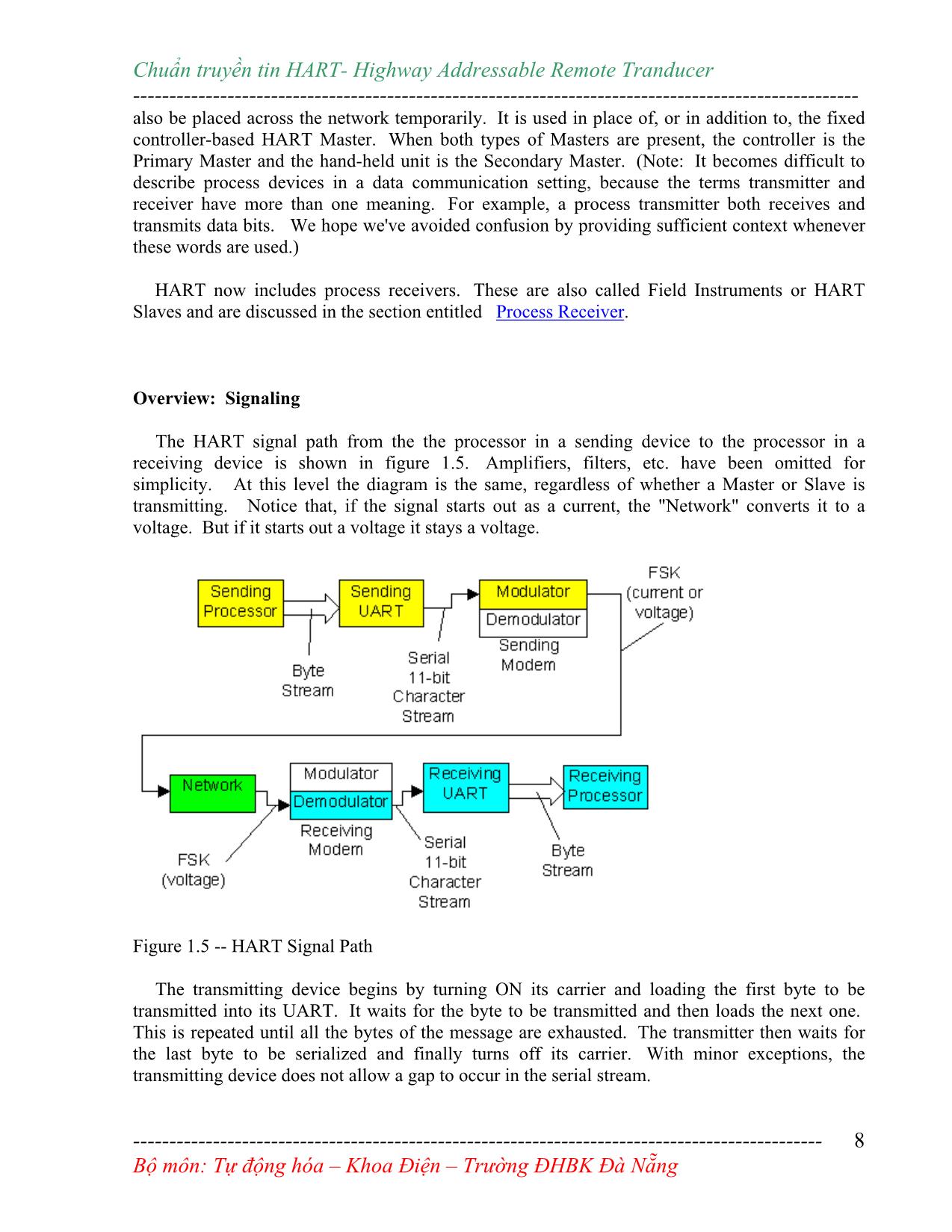
Trang 8
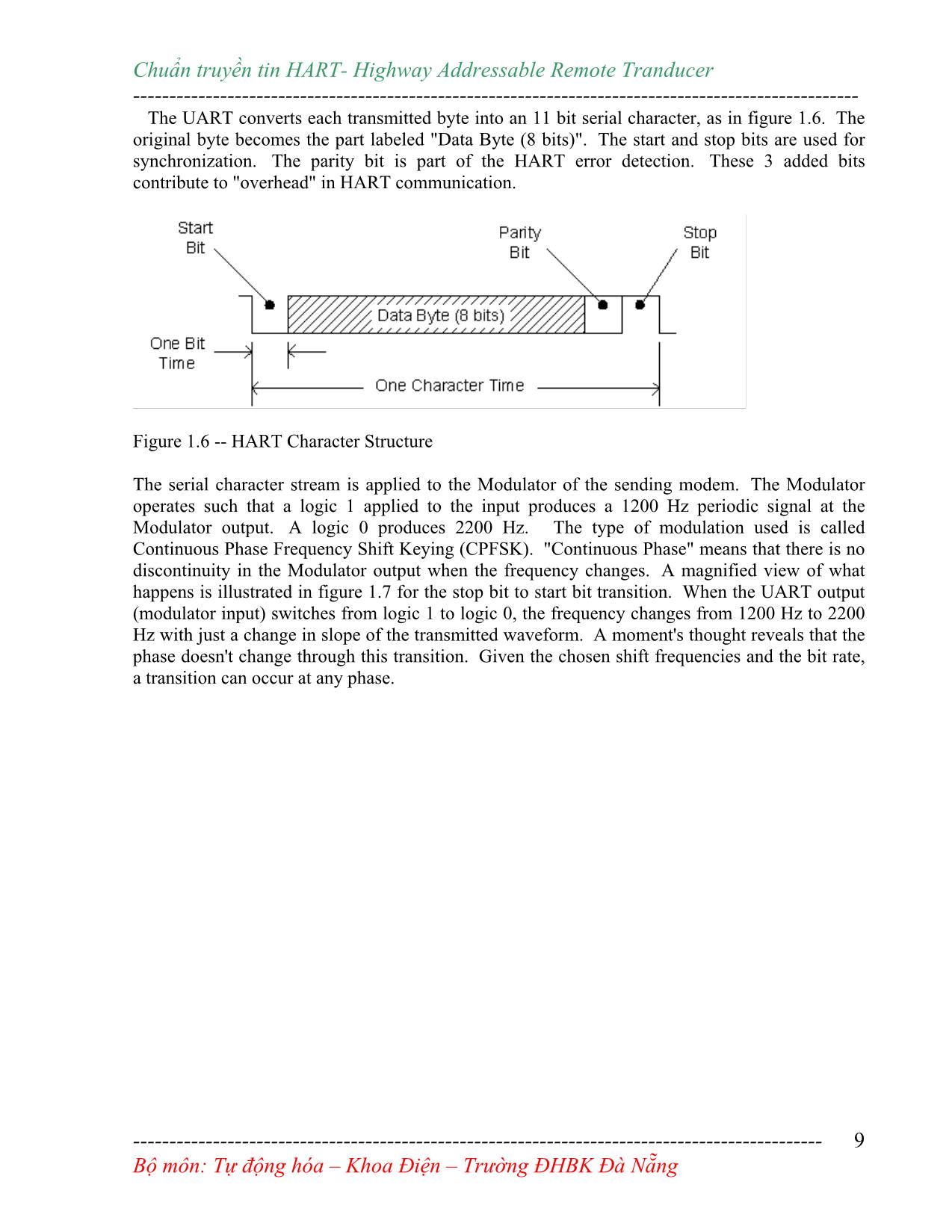
Trang 9
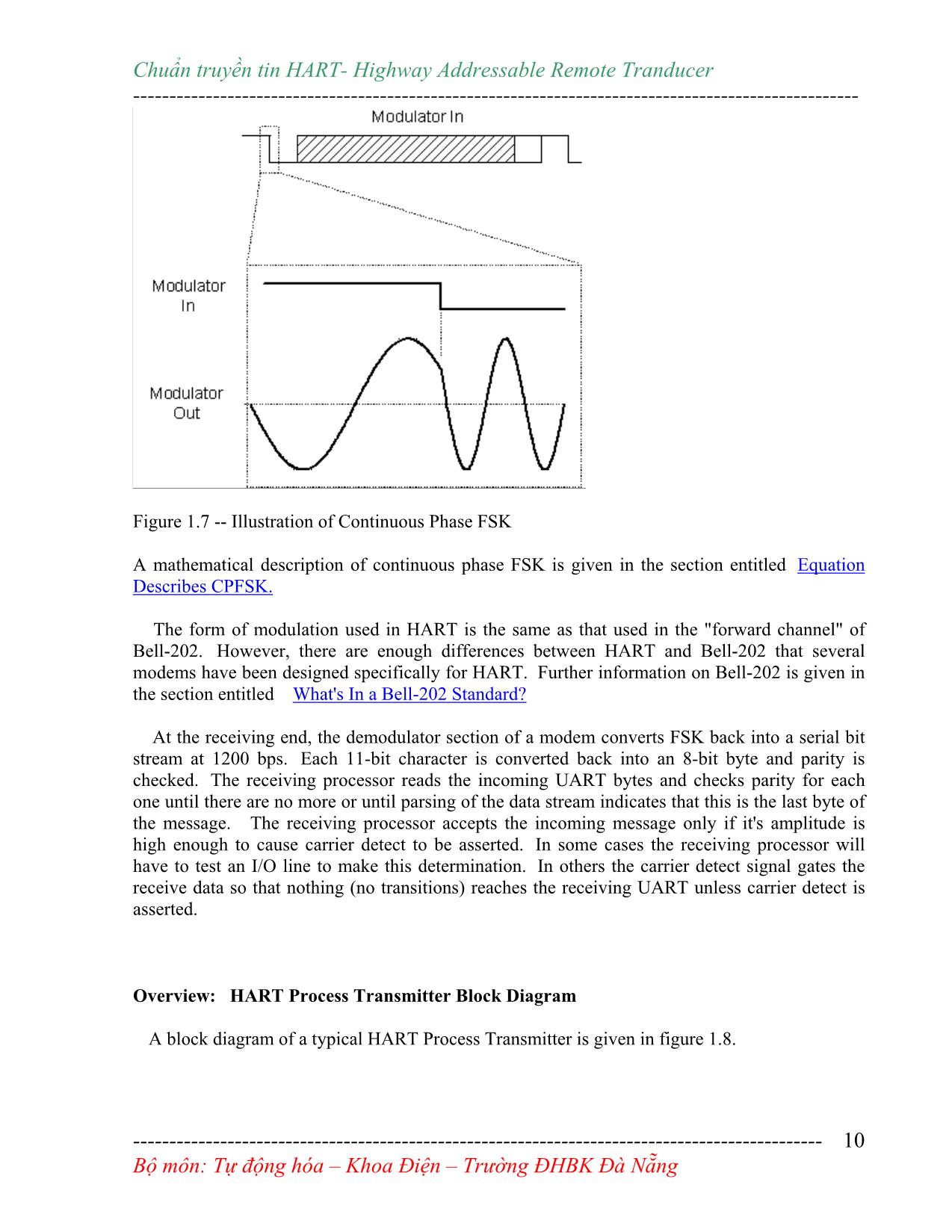
Trang 10
Tải về để xem bản đầy đủ
Tóm tắt nội dung tài liệu: Giáo trình Chuẩn truyền tin Hart trong đo lường và điều khiển tự động mạng công nghiệp
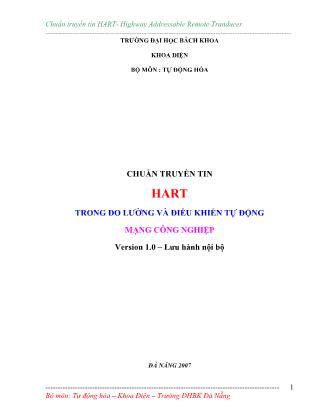
Chuẩn truyền tin HART- Highway Addressable Remote Tranducer ---------------------------------------------------------------------------------------------------- ----------------------------------------------------------------------------------------------- Bộ môn: Tự động hóa – Khoa Điện – Trường ĐHBK Đà Nẵng 1 TRƯỜNG ĐẠI HỌC BÁCH KHOA KHOA ĐIỆN BỘ MÔN : TỰ ĐỘNG HÓA CHUẨN TRUYỀN TIN HART TRONG ĐO LƯỜNG VÀ ĐIỀU KHIỂN TỰ ĐỘNG MẠNG CÔNG NGHIỆP Version 1.0 – Lưu hành nội bộ ĐÀ NẴNG 2007 Chuẩn truyền tin HART- Highway Addressable Remote Tranducer ---------------------------------------------------------------------------------------------------- ----------------------------------------------------------------------------------------------- Bộ môn: Tự động hóa – Khoa Điện – Trường ĐHBK Đà Nẵng 2 GIỚI THIỆU CHUNG HART là một giao thức truyền thông được giới thiệu vào năm 1980, những ứng dụng của HART được phát triển bởi tổ chức HCF. HART cho phép thiết bị làm việc trong môi trường công nghiệp có nhiễu cao và tương thích với các chuẩn 4-20mA. Nó được kiến trúc dựa trên sự xếp chồng tín hiệu số trên nền tín hiệu tương tự 4 – 20mA, nghĩa là nó có dạng tín hiệu lai, cộng tín hiệu một chiều với tín hiệu đã được mã hóa. Do đó các thiết bị có thể nhanh chóng định dạng và xác định đúng thông số cần dùng khi có nhiều thiết bị nối vào chung mạng công nghiệp. Cũng như các chuẩn công nghiệp đã có trong lịch sử, để người sử dụng và các môi trường tiếp nhận không bị ảnh hưởng về tâm lí vật lí, HART cũng cho phép nối Master-Slave dạng PPI và MPI. Các liên kết PPI cho phép kéo dài đường truyền đến 3000m và MPI là 1500m, tối đa của MPI lến đến 15 thiết bị. Tuy nhiên HART có nhược điểm là tốc độ truyền thấp, hiện nay đến 4800 baud. Ngược lại, HART lại cho phép cả thiết bị tương tự và số có thể làm việc trên cùng một mạng. Sau đây sẽ trình bày cụ thể hơn những đặc điểm cơ bản về HART. Tài liệu sau đây vừa trình bày những kiến thức về HART, đồng thời cũng đưa ra những mạch điện cụ thể sử dụng cho các chuẩn đo lượng hiện đại hiện nay. Sinh viên có thể sử dụng các phần kiến thức đó để phục vụ cho quá trình làm bài tập, đồ án môn học, tốt nghiệp và các công tác khác sau này. Chuẩn truyền tin HART- Highway Addressable Remote Tranducer ---------------------------------------------------------------------------------------------------- ----------------------------------------------------------------------------------------------- Bộ môn: Tự động hóa – Khoa Điện – Trường ĐHBK Đà Nẵng 3 About HART -- Part 1 Part1: Preliminaries Introduction HART (Highway Addressable Remote Transducer) provides digital communication to microprocessor-based (smart) analog process control instruments. Originally intended to allow convenient calibration, range adjustment, damping adjustment, etc. of analog process transmitters; it was the first bi-directional digital communication scheme for process transmitters that didn't disturb the analog signal. The process could be left running during communication. HART has since been extended to process receivers, and is sometimes also used in data acquisition and control. HART Specifications continue to be updated to broaden the range of HART applications. And a recent HART development, the Device Description Language (DDL), provides a universal software interface to new and existing devices. HART was developed in the early 1980s by Rosemount Inc. [1.4]. Later, Rosemount made it an open standard. Since then it has been organized and promoted by the HART Communication Foundation [1.5], which boasts some 114 member companies. As the de-facto standard for data communication in smart analog field instruments, HART is found in applications ranging from oil pipelines to pulp and paper mills to public utilities. As of June 1998 an estimated 5 million nodes were installed [1.1]. Among the many HART products now available are Analog Process Transmitters Digital-only Process Transmitters Multi-variable Process Transmitters Process Receivers (Valves) Local (Field) Controllers HART-to-Analog Converters Modems, Interfaces, and Gateways HART-compatible Intrinsic Safety Barriers HART-compatible Isolators Calibrators Software Packages New HART products continue to be announced, despite encroachment by Foundation Fieldbus and other faster networks. Analog transmitters continue to flourish [1.2], which suggests that HART will, also. A recent study [1.3] predicts that, of all smart pressure transmitters sold in the next few years, sales of HART units will increase at 17.5% per year. Analog Services, Inc., a leader in HART development, is pleased to present this on-line book about HART. We have tried to present many topics that do not appear in the HART Standards or App Notes. This is still a work in progress. If there are other topics that you would like to see Chuẩn truyền tin HART ... ------------------------------- Bộ môn: Tự động hóa – Khoa Điện – Trường ĐHBK Đà Nẵng 133 The 20C12 has been discontinued, but has been cloned by Smar. The Smar version is the HT2012. The 20C15 is a 20C12 with increased functionality. This was designed by Gabriel Maalouf of Rosemount Inc., David Tetzlaff of Rosemount Inc., and Stephen Anderson of Analog Services, Inc. Symbios was recently acquired by LSI Logic. There seems to be some question as to whether the 20C15 will survive. A spokesman for Rosemount Inc. says that they (Rosemount) have designed a new chip to replace the 20C15; and that it is pin-compatible with the 20C15. Again, this new chip will be available to HART designers through a major semiconductor vendor. Schoppe & Faeser makes a HART Modem chip (no model number available) that is similar to the 20C15. That is, it has filters and waveshaping and on-board oscillator and consumes about 0.5 mA at 3 V. The June, 1998 issue of Control Magazine estimated that there were about 5 million HART-compatible instruments in use. At about $4 to $5 per chip, this represents modem chip sales of 20 to 25 million dollars. Because Bell-202 is still being used for Caller ID and other special telecom applications, other Bell-202 chips are also available. An example is the Silicon Systems 73K302. These were not designed for HART. They are not low-power and are somewhat cumbersome for use with HART. The Silicon Systems chip, for example, is intended to be connected to the micro-controller data bus and has several registers that must be written to configure and control it. A recent article [Holland, S., "Low-Cost Software: Bell-202 Modem," Circuit Cellar, pp. 12-19, June, 1999] describes the implementation of a Bell-202 Modem entirely in the software of an embedded controller chip. The software is also apparently available for download from Circuit Cellar's web site. This software modem uses a very fast (50 MHz clock) microcontroller chip made by Scenix Semiconductor. The author says that there is still some processing power left over. We suspect that chips running much more slowly could also do the job. On-Line Data Sheet for 20C15 By Analog Services, Inc. The 20C15 HART Modem IC is made by LSI Logic. Unfortunately, they provide only paper copies of the 20C15 data sheet. It does not show up on their web site (at We have created here our own data sheet for the 20C15 to make it easier for HART designers to get this information on the internet. To purchase Chuẩn truyền tin HART- Highway Addressable Remote Tranducer ---------------------------------------------------------------------------------------------------- ----------------------------------------------------------------------------------------------- Bộ môn: Tự động hóa – Khoa Điện – Trường ĐHBK Đà Nẵng 134 the 20C15 integrated circuit or to get a complete copy of the LSI Logic data sheet, contact LSI Logic at LSI Logic Corp. 1551 McCarthy Blvd Milpitas, California 95035 800.433.8778 (in the United States) 408.433.8000 (outside the United States) Fax 408.433.8989 Description The 20C15 is a low-power, single-chip, 1200 bps modem specifically designed to satsify HART Protocol requirements. It contains nearly all of the circuitry needed to add HART communication capability to analog 4-20 mA field instruments. It is specified for use at supply voltages of 3.3 volt and 5.0 volt and over the industrial process control temperature range of -40 C to 85 C. For lowest possible power consumption the modulator portion of the chip is shut down while the demodulator is operating and vice- versa. A crystal or ceramic resonator operating at 460 kHz may be used with the chip to generate a 460 kHz clock. Or a 460 kHz clock may be supplied to one of the 20C15 pins. An external bandgap voltage reference is required to set up reference voltages and the device operating current. The 20C15 includes transmit waveshaping and part of the receive filtering required by HART. The 20C15 is supplied in a 28-pin PLCC package. Pinout Pin Number Name In/Out Description Comment 1,5,7,8,9,14 Test Connect To Ground 2,3,4,25,28 Test Leave Open 6 /RESET In Reset (Low To Reset) Connect To R & C 10 OTXA Out Transmit Out 11 IAREF In Reference Voltage Connect to 1.235 volt for 3.3 volt supply, Connect to 2.5 volt for 5.0 volt supply. 12 ICDREF In Carrier Detect Reference Voltage Set at 80 mV below IAREF 13 OCBIAS Operating Current Set Connect 500k to gnd for 3.3 volt supply, Chuẩn truyền tin HART- Highway Addressable Remote Tranducer ---------------------------------------------------------------------------------------------------- ----------------------------------------------------------------------------------------------- Bộ môn: Tự động hóa – Khoa Điện – Trường ĐHBK Đà Nẵng 135 Connect 1 Meg to gnd for 5.0 volt supply. 15,22 Power Pin Connect to 3.3 volt or 5.0 volt. 16 IRXA In Input to Receive Gain Stage See Circuits 17 ORXAF Out Output from Rcv Gain Stage Low Impedance Point 18 IRXAC In Receive Filter Continued 19 OXTL Out Crystal Oscillator Output 460 kHz 20 IXTL In Crystal Oscillator Input Or External Clock Drive 21 Ground 23 INRTS In Request-to-Send Selects between XMIT and RCV 24 ITXD In Transmit Data 26 ORXD Out Receive Data 27 OCD Out Carrier Detect Operation Modulator (Transmit): The modulator is operating (and the demodulator is shut down) whenever /RTS (INRTS) is low. When TXD (ITXD) is high the modulator output at TXA (OTXA) will be a trapezoidally shaped wave at nominally 1200 Hz. When TXD is low the modulator output is nominally 2200 Hz. TXA (OTXA) is usually AC-coupled to an amplifier or buffer stage. The output voltage levels at TXA depend on the reference voltage applied at IAREF. Let VQ, VMIN, and VMAX be as defined in figure 1. Chuẩn truyền tin HART- Highway Addressable Remote Tranducer ---------------------------------------------------------------------------------------------------- ----------------------------------------------------------------------------------------------- Bộ môn: Tự động hóa – Khoa Điện – Trường ĐHBK Đà Nẵng 136 Figure 1 That is, VQ is the quiescent (no modulation) voltage at TXA, and VMAX - VMIN is the pp signal voltage swing. VQ, VMIN, and VMAX are given by where VREF is the voltage at pin IAREF. For VREF = 1.235 volt, VQ is 0.5 volt and the signal swings from 0.25 volt to 0.75 volt. In a HART Master this is the correct pp voltage to be applied to the network. But the OTXA pin does not have enough drive capability to drive a HART network directly. A buffer amplifier is usually needed. In a field instrument, the 0.5 volt pp OTXA output is usually converted to 1 mA pp. Demodulator (Receiver): The demodulator is operating (and the modulator is shut down) whenever /RTS (INRTS) is high. The received signal is first applied to a bandpass filter. Part of this filter is off-chip. This is necessary to reduce interference to a level that is within the 20C15 supply rails. The bandpass filter consists of a 4-pole highpass filter and a single- pole lowpass. When used with the suggested passive components the overall filter has a gain of 1.6 in the passband. Other pins that are part of the receive filter are IRXA, ORXAF, and IRXAC. The filter output is applied to two comparators -- one to slice the signal and produce a logic-level version of the received FSK and a second to act as a carrier detect. The reference for the first comparator is the reference voltage applied at IAREF. The reference for the second comparator is applied at ICDREF and is normally set to be 80 mV below the level at IAREF. The carrier detect comparator is therefore tripped if the filter output swings low by 80 mV peak or more. Or, since the filter has a passband gain of 1.6, the carrier detect comparator will trip if the input swings by 50 mV peak (100 mV pp) or more. These values are chosen to satisfy the HART requirement that the carrier detect be OFF for input signals 120 mV pp. Logic circuits following the carrier detect comparator are used to decide whether carrier is present. If the input has sufficient amplitude to trip the carrier detect comparator on each of 3 or 4 consecutive cycles, then carrier is present and OCD goes high. Once carrier is present, if the input signal fails to trip the comparator for a time of about 3 or 4 cycles, then carrier is no longer present and OCD goes low. Chuẩn truyền tin HART- Highway Addressable Remote Tranducer ---------------------------------------------------------------------------------------------------- ----------------------------------------------------------------------------------------------- Bộ môn: Tự động hóa – Khoa Điện – Trường ĐHBK Đà Nẵng 137 The logic-level FSK out of the first comparator is applied to a logic block that generates a high level if a frequency below 1700 Hz is present and a low level if a frequency above 1700 Hz is present. The output of this logic block is gated with OCD to form the output RXD (ORXD). If carrier is not present the RXD output is always low. If carrier is present, then RXD equals the output of the logic block. RXD (ORXD) is normally connected to a UART. The UART sees a low level as an assertion of RXD. Therefore, when no carrier is present (no reception occuring) RXD is asserted. In some cases this will appear to be an extra character at the end of a message. The software that services the UART must handle this condition appropriately. Clock: A 460.8 kHz clock is required. This can be generated by connecting a crystal or ceramic resonator across pins OXTL and IXTL (see Circuits). An external clock source can also be used. Connect the external source to OXTL and connect IXTL to ground. Parameters Clock: 460.8 kHz, Tolerance 1%. Power Supply Current: 400 uA max. (3.3 volt supply), 600 uA max. (5.0 volt supply). (NOTE: This is the current during receive. It is about 100 uA to 200 uA less during transmit. This can sometimes be used to advantage.) Operating Temperature Range: 0 C to 70 C. (NOTE: This would seem to preclude using this part in industrial control applications, which usually require -40 C to 85 C. However, this specification is apparently the result of problems in testing the part outside of 0 C to 70 C; and doesn't reflect the part's true capability. It is designed for and is being widely used in equipment specified for -40 C to 85 C.) Reset Minimum Pulse Time: 2 microsecond. Transmit Output Drive Capability: Needs minimum of 30 kohm. Circuits Field Instrument, 3.3 Volt Supply: Chuẩn truyền tin HART- Highway Addressable Remote Tranducer ---------------------------------------------------------------------------------------------------- ----------------------------------------------------------------------------------------------- Bộ môn: Tự động hóa – Khoa Điện – Trường ĐHBK Đà Nẵng 138 Figure 2 Chuẩn truyền tin HART- Highway Addressable Remote Tranducer ---------------------------------------------------------------------------------------------------- ----------------------------------------------------------------------------------------------- Bộ môn: Tự động hóa – Khoa Điện – Trường ĐHBK Đà Nẵng 139 Field Instrument, 5.0 Volt Supply: Chuẩn truyền tin HART- Highway Addressable Remote Tranducer ---------------------------------------------------------------------------------------------------- ----------------------------------------------------------------------------------------------- Bộ môn: Tự động hóa – Khoa Điện – Trường ĐHBK Đà Nẵng 140 Figure 3 Package Figure 4 Package -- 28 Pin PLCC References 1.1. Control Magazine, "You Gotta Have HART ...", June, 1998, Putman Publishing Company 555 Pierce Road, Suite 301, Itasca, Illinois 60143 1.2. Control Engineering Magazine, "4-20 mA Transmitters Alive and Kicking," October 1998. 1.3 ARC Study as reported in I&CS Magazine, "Pressure Transmitter: A Unit For Every Application," November, 1999. 1.4. Rosemount Inc., 12001 Technology Drive, Eden Prairie, MN 55344. 1.5. HART Communication Foundation, 9390 Research Blvd., Suite II-250, Austin, TX, 78759 1.6. HART Field Communications Protocol: A Technical Overview, HCF LIT 20, rev. 2, 1994, HART Communication Foundation. 1.7. Fieldbus Standard for Use in Industrial Control Systems, ISA SP-50, Instrument Society of America. Chuẩn truyền tin HART- Highway Addressable Remote Tranducer ---------------------------------------------------------------------------------------------------- ----------------------------------------------------------------------------------------------- Bộ môn: Tự động hóa – Khoa Điện – Trường ĐHBK Đà Nẵng 141 2.1 Questions on real-time programming in Programming Questions, 2.2 Ramamritham, K., et. al., "Using Windows NT for Real-Time Applications: Experimental Observations and Recommendations," 1998 IEEE Real-Time Technology and Applications Symposium. 2.3 HART Physical Layer Test Procedure, HCF_TEST-2, Revision 1.0, 1995, HART Communication Foundation. 2.4 BS 6305:1992, "General Requirements for Apparatus for Connection to Public Switched Telephone Networks Run By Certain Public Telecommunications Operators," British Standards Institution, Linford Wood, Milton Keynes, MK14 6LE. 2.5 Ott, H.W., Noise Reduction Techniques in Electronic Systems, Wiley, 1976. 2.6 EN50082-2, "Electromagnetic Compatibility Generic Immunity Standard, Part 2: Industrial Environment". 2.7 ENV50141:1993, "Electromagnetic Compatibility -- Basic Immunity Standard -- Conducted Disturbances Induced by Radio-Frequency Fields -- Immunity Test." 2.8 Stahlings, W., ed., Tutorial: Local Network Technology, IEEE Computer Society Press, 1983. 2.9 DeviceNet Standard. Originally developed by Allen-Bradley, now Open DeviceNet Vendor's Association (ODVA) ODVA, PMB 499 * 20423 State Road 7 #F6 * Boca Raton, FL 33498-6797 USA. 2.10 NT International, Minneapolis, MN, 612-502-0200. 3.1 MATLAB, Mathworks, Inc., Natick, MA. 3.2 ISO/IEC 7498-1:1994(E), "Open Systems Interconnection -- Basic Reference Model: The Basic Model," ISO/IEC, Case Postale 56, CH-1211 Geneva 20, Switzerland. 3.3. Bennet, W.R., and Rice, S.O., "Spectral Density and Autocorrelation Functions Associated with Binary Frequency-Shift Keying", Bell System Technical Journal, Sept., 1963. 3.4 Proakis, J.G., Digital Communications, McGraw-Hill, 1983. 3.5 Shanmugam, K.S., "Digital and Analog Communication Systems," 1979, John Wiley & Sons. 3.6 Private Communication with Doug Arntson of Rosemount Inc. 3.7 Private Communication with Jay Warrior of Rosemount Inc.
File đính kèm:
 giao_trinh_chuan_truyen_tin_hart_trong_do_luong_va_dieu_khie.pdf
giao_trinh_chuan_truyen_tin_hart_trong_do_luong_va_dieu_khie.pdf

